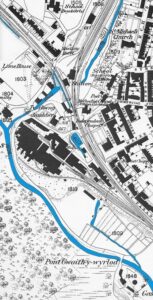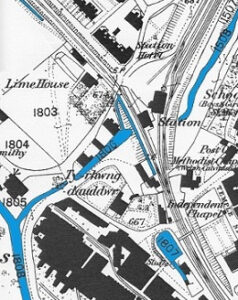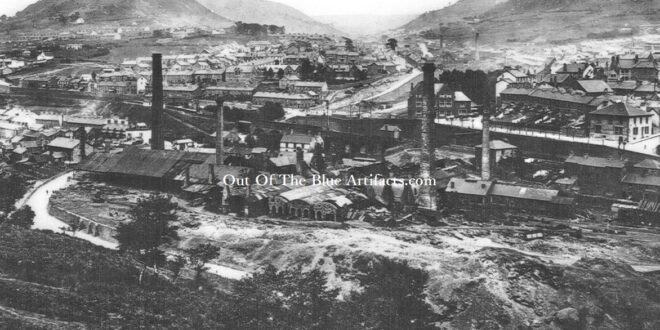Abertillery Tin Works, Station Road, Abertillery.
The Abertillery Tin Works were built in the late 1840’s on the ground that was once occupied by the earlier Iron Works constructed sometime in the 1830’s (where Tesco’s Supermarket is today). The old iron works was on the land registry maps of 1840 (as seen in another image on the site), six years before the Abertillery Tin Works were erected.
In old reports Mr Richard Walker was the first Iron Master of Abertillery in the 1830’s. He was sending iron down the valley from 1832 to 1839. Mr Richard Walker was from Pontypool, his daughter Miss Harriet Walker married Mr William Webb (Brewer and Maltster of Aberbeeg). Mr Richard Walker was also a magistrate and often attended court at Blaina during this time.
Mr J. Conway and Mr J. Pearce.
In the late 1840’s the Abertillery Tin Works were opened by Mr J. Conway and Mr J. Pearce. Mr Conway was a magistrate and was instrumental in the building of the British School, Abertillery.
Mr Charles Frederick Medhurst.
Mr Charles Frederick Medhurst was the manager at the Abertillery Tin Works. Mr Charles Medhurst, born in 1815 at Manchester. Mrs Jane Medhurst nee Gorst?, born in 1821 at Cheshire, England. They were married in 1844 and on the 1851 census Mr Medhurst was a book keeper and later manager at the tin works and lived on the Western Valley Line, Abertillery. This address was close to Abertillery House, later known as the Limes House.
 The Tin Works Feeder.
The Tin Works Feeder.
When the tin works were installed a feeder stream to power the water wheels at the works was constructed. Its course was from a sluice in the River Ebbw close to Spiders Castle (where Harcourt Terrace is today) to the works via the fields (where Glandwr Street is today) across the front of the Station Hotel and down into another sluice at Station approach, the sluice could divert the water back into the River Tillery at this point if the pond was full.
This feeder kept the pond full of water to power the tin works machinery. It’s hard to believe but the sluice for the feeder at Spiders Castle was 36′ feet higher above sea level than the tin works. This height difference maintained a constant forceful flow to the pond. When Glandwr Street was built the feeder was covered over and the houses were built over it.
 Above is the extended view of the area showing the feeder route from the (top left), down through into the pond via a sluice in front of the Station Hotel at the junction with the River Tillery. The overflow is let back into the River Tillery and the waste after production is let back into the River Ebbw as seen (bottom right).
Above is the extended view of the area showing the feeder route from the (top left), down through into the pond via a sluice in front of the Station Hotel at the junction with the River Tillery. The overflow is let back into the River Tillery and the waste after production is let back into the River Ebbw as seen (bottom right).
As seen (right) is an enlarged view of the sluice in front of the Station Hotel.
In 1850 Mr John Conway announced he was paying his workforce in the coin of the realm and would not entertain the idea of issuing Truck Tokens. In the same year he offered free train fare to his workers to go shopping at Newport or Bristol (employees’ choice) once a month.
The Patriotic Fund.
On Saturday 2nd of December 1854, Mr Charles Medhurst presided over a meeting of the tin works workmen and others employed at Abertillery. It was resolved to contribute to the Patriotic Fund, a fund to provide for the widows and orphans of the men fighting in Crimea. It was proposed by Mr David Jenkins and carried unanimously that “each individual employed at the tin works contribute one days pay to aid the benevolent fund”. Mr Watkin Rowland delivered a speech and a sum of £27. 1s. 0d. was raised.
The Death of Mr John Conway.
(More information to come).
Messrs T. P. & D. Price and J. Pearce.
In 1858 the Abertillery Tin Works were sold to T. P. & D. Price and J. Pearce. (T. P. & D. Price were Messrs Thomas Protheroe Price and David Price) colliery proprietors and the original owners of the Penybont Tillery Colliery, Abertillery).
Additional Information.
The following information is taken from a report printed in the Hereford Times on Saturday 17th of September 1859. “A Presentation to the Manager of the Tin-Plate Works”. On Saturday week, a presentation to the Manager Mr Charles Frederick Medhurst Esq took place when agents and 300 workmen and their families had tea in the tin room at the works. Mr Medhurst was presented with a beautiful silver dessert stand with an elegant plateau supplied by Messrs A. B. Savory and Sons of London. The base of the Epergne had an appropriate inscription which was elaborately engraved.
After tea Mr Sheldon Jones was voted to the chair and was supported by the Following – Mr Charles Medhurst; Mrs Medhurst; Mr W. J. Clapp Esq (Surgeon); Mrs Clapp; Mr John Price Esq; Rev James Hughes of Llanhilleth; Rev John Jones of Abertillery; Mr and Mrs King (Master and Mistress of the National School); Mrs Kirkman; Mr Bevan (Master of the British Schools) and Miss Dunford:
At this stage, the chairman spoke of the early history of Abertillery, he said Abertillery is situate in what was formerly designated the “Wilds of Monmouthshire” and was remarkable only for its rugged and romantic scenery, with those little hardy sheep which, fleet as the roebuck, climb the hills that encircle it. It consisted of a few houses, with a meeting-house at Blaenau Gwent, for members of the Anabaptist* persuasion. A start was effected in making iron by Mr Walker and at a later period Mr Webb erected a water-wheel and began manufacture of tin plates.
In the year 1849 the march of progress, commenced by Walker and Webb received a fresh impetus, the works fell into the hands of more enterprising proprietors. Considerable enlargements were decided upon. The forge, new mills, annealing room and tin-house were erected, and this, together with the development of of the mineral treasures which lie around and underneath us, brought together a great body of immigrants from various parts of the country. The church and various chapels, together with the National and British Schools, attest that the the religious wants and mental training of the inhabitants, numbering from 1,500 to 2,000 have not been forgotten. Other names that attended and were reported were – Mr Watkin Rowland and Mr Daniel Daniel.
Anabaptist* meaning – The doctrine that baptism should only be administered to believing adults, held by a radical Protestant sect of the 16th century.
Bar Iron.
In 1866 it was announced that the Abertillery Tin Works were producing their own bar-iron.
Mr John Conroy.
In the late 1860’s Mr John Conroy became manager at the Abertillery Tin Works. On the 1871 census Mr Conroy was born in 1824 at Clapham, Surrey. His wife, Mrs Annie Conroy was born in 1834 at Farnham, Surrey. The couple lived at Aber House (adjacent to Forge Row, Abertillery, as yet to be identified) with their son Master Arthur John Conroy born in 1870 at Abertillery and their daughter Miss Isabel Fanny Conroy born in 1870 at Abertillery.
The Abertillery Tin Plate Co.
In 1869 the Abertillery Tin Works were in the hands of Mr J. Pearce and known as the Abertillery Tin Plate Co. Mr J. Pearce went bankrupt in the same year of 1869.
Major Phillip Samuel Phillips.
After the bankruptcy of Mr Pearce, the tin works was purchased by Major Phillip Samuel Phillips. Mr P. S. Phillips also owned the Coedcae Tilllery Coal Levels (where upper Arael View is today) and used the coking ovens on site to supply the tin works (the coking ovens were close to where the Rose Heyworth Millennium School is today). Major Phillips was a keen cricket supporter and gave the Abertillery Cricket Club use of his land at Glandwr (called Captains Field) to use as their ground, this ground was later purchased by a housing company to build Glandwr Street.
Mr John Matthews.
In November 1870, the Star of Gwent newspaper reported that Mr John Matthews had rolled iron at a weight of 3cwt hundred-weight without any break or damage to the piece. On the 1871 census Mr Matthews a tin works labourer lived with his wife Sarah? and family at Matthews Houses, Abertillery close to the Golden Lion Inn on what is now Castle Street.
Large Castings.
On Thursday 25th of May 1871, the South Wales Daily Telegram ran a story in connection with the tin works and a Newport foundry – The Britannia Foundry of Messrs Pearce, Richards & Co at Newport cast a fly-wheel 18′ feet in diameter weighing 24 tons and a bed-plate weighing 13 tons, said to have been the largest ever produced in Newport, South Wales. Both castings were to be used in the tin works at Abertillery, the mill in which they were to be used will be one of the largest in the neighbourhood connected with the manufacture of tin.
Weekly Wages and a Co-operative Society.
On Friday 18th of April 1873, the Monmouthshire Merlin newspaper reported that Mr P. S. Phillips, the owner of the Tin Works at Abertillery had introduced a system of weekly wages, he also placed at the disposal of the men £200 to start a Co-operative Society. The sum of £200 offered by Mr Phillips in 1873 is equivalent to £27,200 in today’s money.
The Rolling Mills.
In 1876 the tin works had six rolling mills in operation.
The Blaina Tin Works.
In August 1879, the South Wales Daily News reported that Mr P. S. Phillips had purchased the Blaina Iron Works and will convert it into a tin works.
Annual Works Outing.
On Saturday 29th of July 1893, the South Wales Argus reported on the Abertillery Tin Works annual outing on the previous Saturday. It was stated that Swansea was selected and it was estimated that 700 went on the trip, the party arrived back at Abertillery at 10.30pm.
The Rolling Mills.
In 1893 the tin works had nine rolling mills in operation.
The Glan Ebbw Steel Sheet, Galvanising and Tin Plate Co Ltd.
In 1899 the Abertillery Tin Works were registered as the Glan Ebbw Steel Sheet, Galvanising and Tin Plate Co Ltd. The directors named as Mr C. Saunders, Mr A. Tilney and Mr J. A. Davies.
Mr Arthur Tilney.
In 1900 Mr A. Tilney formed a company to take over control of the works. The works now had ten rolling mills, five sets of cold rolls and fourteen tinning sets. Mr A. Tilney was also a timber merchant, his timber business became one of the biggest in South Wales.
The Abertillery Works Ltd.
In 1914 the Abertillery Tin Works were registered as the Abertillery Works Ltd.
Productivity and Sales.
At one time the Abertillery Tin Works employed four-hundred men and fifty girls. The workforce produced 350,000 tin plate boxes for the home market which included names such as Fry’s, Cadbury and Nestles Co and manufactured tinned plate for dry and wet goods for export around the world such as South Africa, Jamaica, India and New York. Competition from much bigger companies forced the tin works to close.
The Closure of the Abertillery Tin Works.
On Thursday 12th September 1957 it was officially announced that the Abertillery Tin Works were to close. It was stated that the orders received would be completed in October and November, after which the works would close. It was reported that there were 300 men employed at the works.
Messrs Webb’s Brewers of Aberbeeg.
Following discussions on the use of the site post-tin works it was mentioned that Messrs Webb’s Brewers of Aberbeeg was interested in using the area, although the paperwork was going ahead nothing more came of it and the land was later purchased by Warwills Iron Founders, Abertillery.
The Demolition of the Smokestacks.
On Saturday 6th of June 1959, three of the old tin works smokestacks were demolished by explosives. The residents complained they had hardly any prior notice and were caught off-guard with the resulting blasts smashing windows at Forge Row and Glan Ebbw Terrace, it was said that only the far end of the rows escaped damage. One woman was bed-ridden and the explosion blew her out of bed and onto the floor.
Warwills Foundry.
In 1959 Warwills Foundry moved to the old tin works site, they employed seventy people and expanded in total and expanded their area of works. The foundry behind Church Street became its engineering department while the old tin works site was used to make its castings.
The Story of the Abertillery Foundry – Warwills, Church St, Abertillery.
In 1874 the Abertillery Foundry was opened by Mr John Ward Williams, the foundry was situated on the banks of the River Tylery behind Church Street, Abertillery. Mr John Ward Williams was an old inhabitant of Abertillery, his father was Mr Crawshay Bailey’s manager at the Nantyglo Works. Mr J. Ward Williams lived in Church Street Abertillery, he later lived at Blaenau Gwent and died in 1893, his son Mr Henry Ward Williams took over the business.
The Closure of the Abertillery Iron Foundry.
In 1925 the Abertillery Iron Foundry closed.
Mr J. H. Cole.
In 1926 the foundry was reopened and was owned by Mr J. H. Cole.
Warwills Foundry and Engineering Works.
In 1927 the foundry was registered as Warwills Foundry and Engineering Works.
In 1940 the government asked Warwills Foundry and Engineering Works to make agricultural machinery and tank parts for the war effort.
In 1959 the foundry employed 70 people and expanded down to the now derelict tin works site at Station Rd. The foundry behind Church Street became its engineering department while the old tin works site was used to make its castings.
Abertillery Holdings.
In 1987 the Abertillery Foundry was owned by Abertillery Holdings. A new building was erected at the Station Road site to house their engineering dept. Land to the south of the Station Road site was sold to Low-Cost Supermarket and the Church Street Foundry was sold.
In 1989 Abertillery Holdings moved its head office to Bristol.
Sycamore Holdings.
In 1991 the company was registered as Sycamore Holdings.
The Bawn Bros.
In 1992? the Abertillery Foundry was owned by Bawn Bros.
In 1997 the Bawn Bros moved all operations to Aberbeeg and incorporated with Blackwood Engineering. They then sold the Abertillery site to Tesco Supermarket.
Tesco Supermarket.
On Monday 19th of October 1998, the Tesco Supermarket which had been constructed on the site of the old tin works, and iron foundry, between Castle Street and Aberbeeg Road, Abertillery, was officially opened. Mr Reno Psaila was the manager of the store which was said to have employed 200 staff.
 Out Of The Blue Artifacts A Library of a lifetime of collecting
Out Of The Blue Artifacts A Library of a lifetime of collecting
